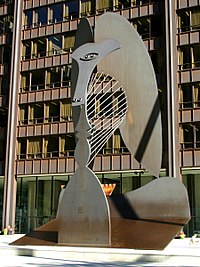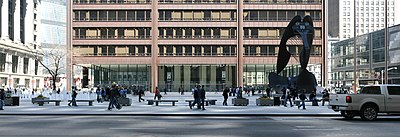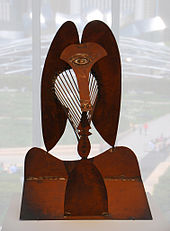
Pablo Ruiz Picasso was a Spanish painter, sculptor, printmaker, ceramicist, and theatre designer who spent most of his adult life in France. One of the most influential artists of the 20th century, he is known for co-founding the Cubist movement, the invention of constructed sculpture, the co-invention of collage, and for the wide variety of styles that he helped develop and explore. Among his most famous works are the proto-Cubist Les Demoiselles d'Avignon (1907) and the anti-war painting Guernica (1937), a dramatic portrayal of the bombing of Guernica by German and Italian air forces during the Spanish Civil War.

Grant Park is a large urban park in the Loop community area of Chicago, Illinois. Located within the city's central business district, the 319-acre (1.29 km2) park's features include Millennium Park, Buckingham Fountain, the Art Institute of Chicago, and the Museum Campus.
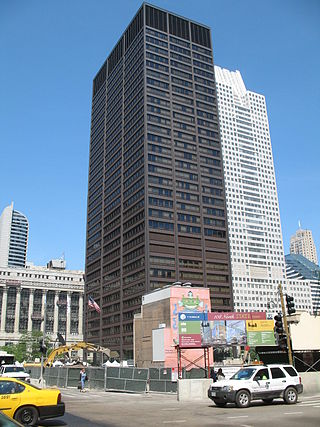
The Richard J. Daley Center, also known by its open courtyard Daley Plaza and named after longtime mayor Richard J. Daley, is the premier civic center of the City of Chicago in Illinois. The Center's modernist skyscraper primarily houses offices and courtrooms for the Cook County Circuit Courts, Cook County State's Attorney and additional office space for the City and the County. It is adjacent to the City Hall-County Building. The open granite-paved plaza used for gatherings, protests, and events is also the site of the Chicago Picasso, a gift to the city from the artist.
Events from the year 1954 in art.
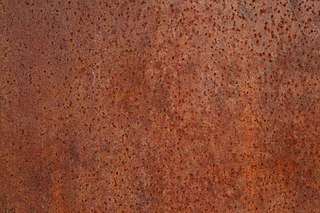
Weathering steel, often referred to by the genericised trademark COR-TEN steel and sometimes written without the hyphen as corten steel, is a group of steel alloys which were developed to eliminate the need for painting, and form a stable rust-like appearance after several years' exposure to weather.
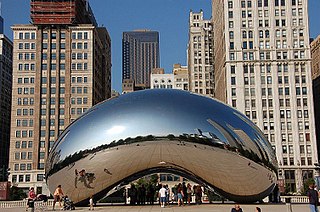
Cloud Gate is a public sculpture by Indian-born British artist Anish Kapoor, that is the centerpiece of AT&T Plaza at Millennium Park in the Loop community area of Chicago, Illinois. The sculpture and AT&T Plaza are located on top of Park Grill, between the Chase Promenade and McCormick Tribune Plaza & Ice Rink. Constructed between 2004 and 2006, the sculpture is nicknamed "The Bean" because of its shape, a name Kapoor initially disliked, but later grew fond of. Kapoor himself even uses this title when referring to his work. Made up of 168 stainless steel plates welded together, its highly polished exterior has no visible seams. It measures 33 by 66 by 42 feet, and weighs 110 short tons.

Flamingo, created by noted American artist Alexander Calder, is a 53-foot-tall (16 m) stabile located in the Federal Plaza in front of the Kluczynski Federal Building in Chicago, Illinois, United States. It was commissioned by the United States General Services Administration and was unveiled in 1974, although Calder's signature on the sculpture indicates it was constructed in 1973.

Miró's Chicago is a sculpture by Joan Miró in Brunswick Plaza, Chicago, United States. It is 39 feet (12 m) tall, and is made of steel, wire mesh, concrete, bronze, and ceramic tile.

Boeing Galleries are a pair of outdoor exhibition spaces within Millennium Park in the Loop community area of Chicago in Cook County, Illinois, United States. The spaces are located along the south and north mid-level terraces, above and east of Wrigley Square and the Crown Fountain. In a conference at the Chicago Cultural Center, Boeing President and Chief Executive Officer James Bell to Chicago Mayor Richard M. Daley announced Boeing would make a $5 million grant to fund both the construction of and an endowment for the space.

The University Village is a complex of three apartment buildings located in Greenwich Village in the Lower Manhattan-part of New York City. The complex is owned by New York University and was built in the 1960s as part of the university's transition to a residential college. It is composed of 505 LaGuardia Place, a co-op that does not house students, and Silver Tower I and Silver Tower II, which house faculty and graduate students of NYU. The buildings were designed by modern architects James Ingo Freed and I. M. Pei, and the central plaza contains a sculpture by Carl Nesjär and Pablo Picasso. In 2008 the complex became a New York City designated landmark.
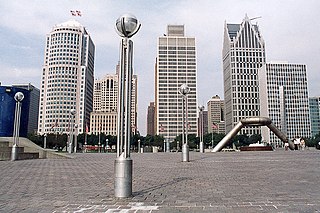
Philip A. Hart Plaza, in downtown Detroit, is a city plaza along the Detroit River. It is located more or less on the site at which Antoine Laumet de La Mothe, sieur de Cadillac landed in 1701 when he founded Fort Pontchartrain du Détroit, the settlement that became Detroit. In 2011, the Detroit-Wayne County Port Authority opened its new cruise ship passenger terminal and dock at Hart Plaza, adjacent to the Renaissance Center, which receives major cruise ships such as the MS Hamburg and the Yorktown.
Pablo Eduardo is a Bolivian sculptor. He creates a wide variety of sculptures for many purposes. Although he sculpts in many different countries, most of his major works have been made in the United States, England, and Bolivia.
Picasso: Magic, Sex, & Death (2001) is a three-episode Channel 4 film documentary series on Pablo Picasso (1881–1973) presented by the artist's friend and biographer John Richardson, and directed by Christopher Bruce or British art critic Waldemar Januszczak, who was also the series director. On-screen contributors include Picasso descendants such as Paloma Picasso, Bernard Ruiz-Picasso, Diana Widmaier-Picasso, Maya Picasso, and Claude Picasso; along with authorities such as Mary Ann Caws, Billy Klüver, Gérard Régnier, James Lord, Bernard Minoret, Robert Rosenblum, Linda Gasman, Marilyn McCully, David Gilmore and Gertje Utley; one former mistress ; and one flirtation.

Modern sculpture is generally considered to have begun with the work of Auguste Rodin, who is seen as the progenitor of modern sculpture. While Rodin did not set out to rebel against the past, he created a new way of building his works. He "dissolved the hard outline of contemporary Neo-Greek academicism, and thereby created a vital synthesis of opacity and transparency, volume and void". Along with a few other artists in the late 19th century who experimented with new artistic visions in sculpture like Edgar Degas and Paul Gauguin, Rodin invented a radical new approach in the creation of sculpture. Modern sculpture, along with all modern art, "arose as part of Western society's attempt to come to terms with the urban, industrial and secular society that emerged during the nineteenth century".

Carl Nesjar was a Norwegian painter, sculptor and graphic artist. He is best known for his collaborations with Pablo Picasso; serving for nearly twenty years as Picasso's chosen fabricator — the artist who turned Picasso's drawings and scale models into large public sculptures. One such work was Picasso's Regjeringskvartalet murals which are located in Oslo, the city where Nesjar lived for most of his life. He is also known for his series of "Ice Fountains” which can be found in cities around the world.

Diana Widmaier Picasso is a French art historian specialized in modern art, living in Paris.
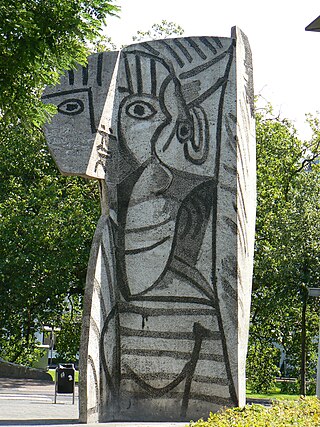
Lydia Corbett is a French artist and former artist's model known for being "the girl with the ponytail" in Pablo Picasso's Sylvette series of paintings and a 1970 sculpture.

Femme au Chien is an oil-on-canvas painting by Pablo Picasso, which he painted in 1962. It is a portrait of Picasso's second wife, Jacqueline Roque, and their dog Kaboul, an Afghan Greyhound. The painting is an illustration of the great affection that Picasso displayed for both of the subjects in the portrait and has elements of the cubist style that he pioneered. It was produced in Picasso's later years when the couple was living at Notre-Dame-de-Vie, near Mougins, France. On 14 May 2019, it was sold at Sotheby's auction for almost $55 million and is now housed in the collection of Wynn Fine Art in Florida.
